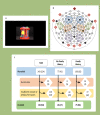Modulation of EEG theta by naturalistic social content is not altered in infants with family history of autism
- PMID: 36456597
- PMCID: PMC9715667
- DOI: 10.1038/s41598-022-24870-7
Modulation of EEG theta by naturalistic social content is not altered in infants with family history of autism
Abstract
Theta oscillations (spectral power and connectivity) are sensitive to the social content of an experience in typically developing infants, providing a possible marker of early social brain development. Autism is a neurodevelopmental condition affecting early social behaviour, but links to underlying social brain function remain unclear. We explored whether modulations of theta spectral power and connectivity by naturalistic social content in infancy are related to family history for autism. Fourteen-month-old infants with (family history; FH; N = 75) and without (no family history; NFH; N = 26) a first-degree relative with autism watched social and non-social videos during EEG recording. We calculated theta (4-5 Hz) spectral power and connectivity modulations (social-non-social) and associated them with outcomes at 36 months. We replicated previous findings of increased theta power and connectivity during social compared to non-social videos. Theta modulations with social content were similar between groups, for both power and connectivity. Together, these findings suggest that neural responses to naturalistic social stimuli may not be strongly altered in 14-month-old infants with family history of autism.
© 2022. The Author(s).
Conflict of interest statement
The authors declare no competing interests.
Figures



References
-
- American Psychological Association . Diagnostic and statistical manual of mental disorders. American Psychiatric Publishing; 2013.
Publication types
MeSH terms
Grants and funding
LinkOut - more resources
Full Text Sources
Miscellaneous

